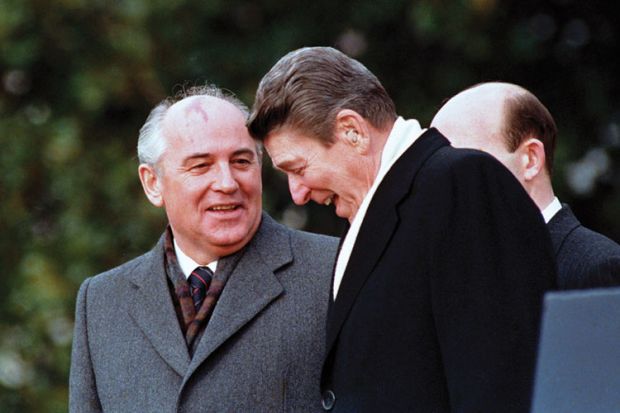There are four main characters in Robert Service’s masterful chronicle about personalities and ideas: Mikhail Gorbachev, Ronald Reagan, Eduard Shevardnadze and George Shultz – and a fifth, George H. W. Bush, who completed his predecessor’s work. It is a captivating story of perceptions and misperceptions, intrigues and deception, warnings, allusions, misgivings and illusions, and a chain of events that resulted, almost miraculously, in the end of the Cold War and of the looming risk of humanity’s extinction in a thermonuclear Armageddon.
At the moment of the aborted putsch against Gorbachev in August 1991, the Communist Party created by Lenin was for all practical purposes defunct. One could apply to it Rosa Luxemburg’s famous description of the German Social Democratic Party in 1914: a stinking corpse. This happened as an unintended effect of Gorbachev’s increasingly bold reforms. Aimed at saving the system, these reforms would lead instead to a peaceful revolution.
East German strongman Erich Honecker’s suspicions were right when, attending the celebration of the 70th anniversary of the Bolshevik insurrection in Moscow in November 1987, he complained bitterly about Gorbachev’s abandonment of Marxism-Leninism. Together with the Romanian autocrat Nicolae Ceauşescu, Honecker realised that the monolithic times were over. The prospects for a Soviet intervention to rescue dying totalitarian regimes were nil.
Initially, Gorbachev’s perestroika was merely a prolongation of Yury Andropov’s lukewarm streamlining. At the same time, it was desperately important for the man elected general secretary of the Communist Party in March 1985 to convince the West of his good faith and halt the US’ huge investment into Reagan’s pet military project, the Strategic Defense Initiative. For Gorbachev, schooled in the rusty shibboleths of party ideology, the West was intent on destroying the Soviet Union. He was a quick learner, however, and changed his mind. A new vision in foreign policy emerged, spurred by Gorbachev’s close ally, Shevardnadze, the Georgian party boss whom he appointed foreign minister. Together with another influential figure, party ideologue Alexander Yakovlev, Shevardnadze convinced Gorbachev that the old institutional edifices were irretrievably obsolete. Service suggests that Shevardnadze’s non-Bolshevism came from his appreciation of the short-lived Georgian Menshevik government.
In Service’s account, Reagan appears as a tenaciously determined leader, driven by a strong belief in the need to pressure the Soviets to permit real freedom. Reagan’s often-derided lack of sophistication was a myth: he knew how the USSR was ruled and made it clear to Gorbachev that he was not fooled by empty sloganeering. Shultz’s pragmatic vision and his repudiation of ideological blinkers played a crucial role in making the negotiations more than a dialogue of the wilfully deaf. Service focuses on the inner tensions within the Reagan administration, especially between the CIA and the Pentagon on the one hand, and the State Department on the other. Reagan navigated wisely between the policy recommendations coming from these institutions. His October 1987 Berlin Wall speech would bring satisfaction to both sides of the Cold War divide: it was a reaffirmation of the American rejection of totalitarianism, but also an invitation to Gorbachev to move forward with democratisation.
The Cold War ended with the demise of the USSR in December 1991. The great biographer of Lenin, Stalin and Trotsky here offers a superb account of how and why this unexpected denouement came about.
Vladimir Tismaneanu is professor of politics, University of Maryland (College Park) and author of The Devil in History: Communism, Fascism, and Some Lessons of the Twentieth Century (2012).
The End of the Cold War: 1985-1991
By Robert Service
Pan Macmillan, 562pp, £25.00
ISBN 9780230748088
Published 8 October 2015
POSTSCRIPT:
Print headline: Men who came in from the Cold
Register to continue
Why register?
- Registration is free and only takes a moment
- Once registered, you can read 3 articles a month
- Sign up for our newsletter
Subscribe
Or subscribe for unlimited access to:
- Unlimited access to news, views, insights & reviews
- Digital editions
- Digital access to THE’s university and college rankings analysis
Already registered or a current subscriber?




